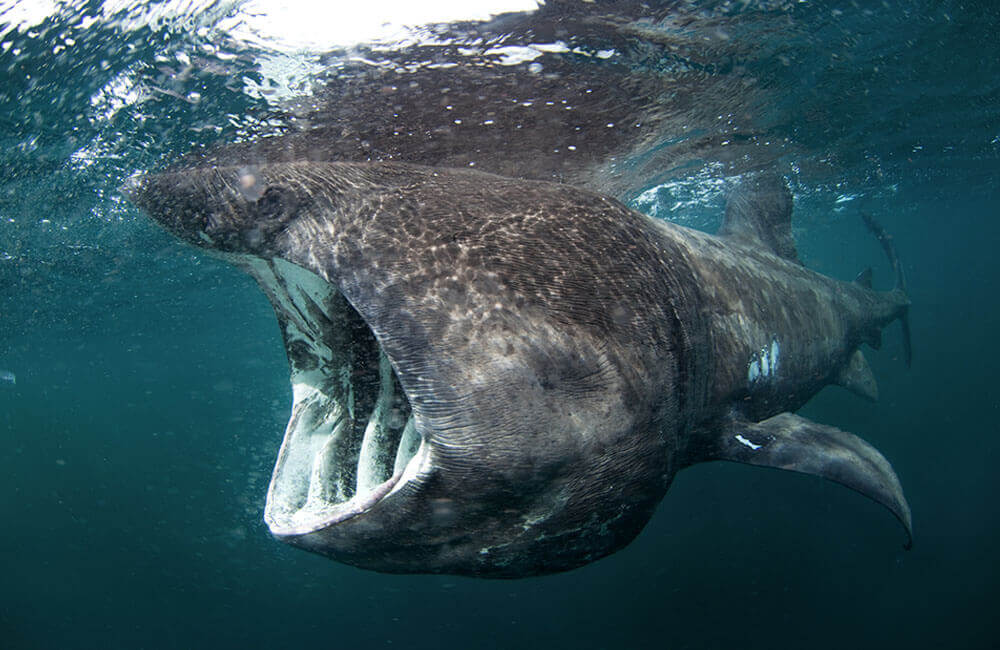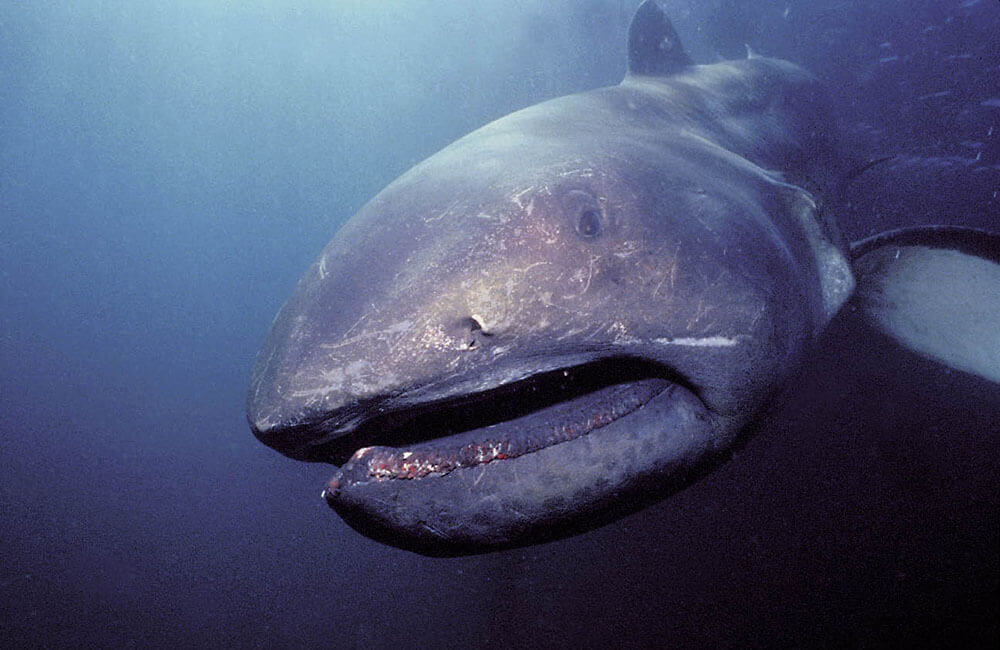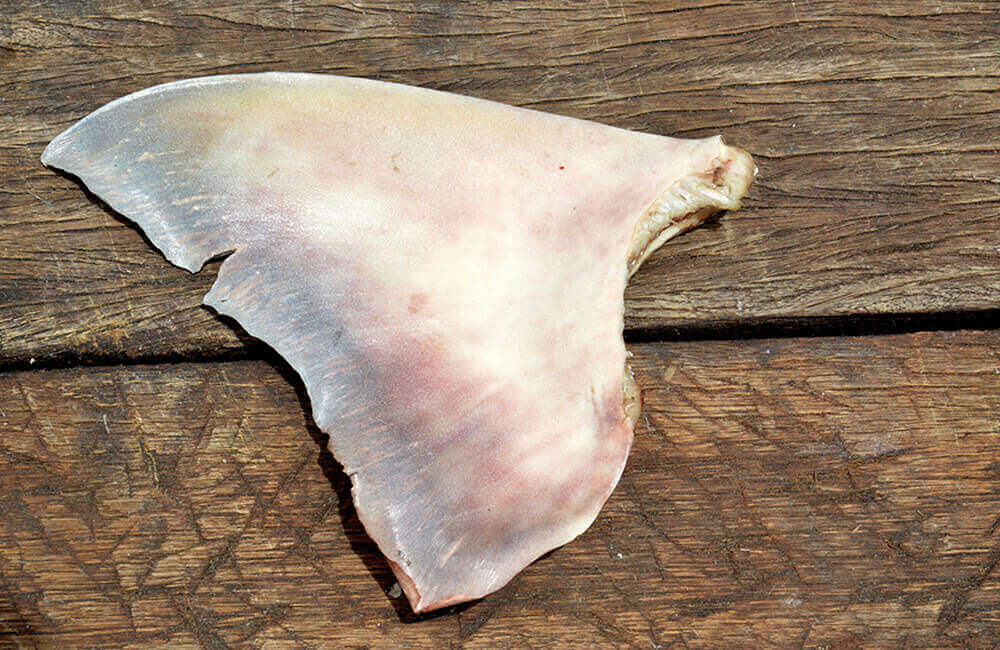
Basking sharks (Cetorhinus maximus) are the second-largest species of shark – and therefore the second-largest species of fish – in the oceans. Here are some of the most important facts about one of our favourite shark species
By Mark ‘Crowley’ Russell
How big are basking sharks?
Basking sharks are ovoviviparous, which means that the embryos gestate inside eggs that remain inside the mother’s body, and babies are born measuring between 1.5-2 m (5-6.5 ft) in length – about the average size of an adult grey reef shark.
Adult basking sharks typically reach up to 9.1 m (30 ft) in length. The largest basking shark ever recorded was found in the Bay of Fundy, Canada, in 1851 and measured a whopping 40.3 ft (12.3 m) in length – about the same as your average London bus.
Basking sharks are second in size only to whale sharks, the largest accurately measured example of which – around 18 m (61.7 ft) in length – would have dwarfed the largest ever basking shark by an extra 6.5 m (21.4ft). Almost two average-sized basking sharks stuck together, in fact.
It’s a sea monster with a big nose

The taxonomical name Cetorhinus maximus was first bestowed upon the basking shark in 1765 by Norwegian bishop and botanist Johan Ernst Gunnerus.
Cetorhinus maximus is a composite of cetos, or cetus, derived from the ancient Greek κῆτος (ketos), a generic definition of ‘sea monster’ in ancient Greece and now the modern Greek word for whale.
Rhinus – like the rhinoceros – is derived from the ancient Greek ρίς (rhī́s), meaning ‘nose’, and maximus is a Latin word meaning ‘biggest’ or ‘greatest’. So, quite literally, ‘sea monster with the nose biggest’.
Other names

Basking sharks have gone by many different names over the centuries. The species’ first scientific name was Squalus maximus, which just means ‘biggest shark’ – and it’s never a good idea to classify a species definitively just in case something bigger – such as whale sharks, for example – turns up later.
Italians called it the Squalo elefante – elephant shark – probably because of its giant snout; the Germans called it the Risenhai – giant shark – and in Spain, it was named the Tiburón peregrino, or ‘pilgrim shark’.
Basking sharks were also once termed sailfish – for the giant fin that sticks out of the water like a sail – and were also commonly known as sunfish for some time, until Welsh naturalist Thomas Pennant changed the name in 1769 to stop basking sharks being confused with actual sunfish, also known as mola mola, which are often found in similar locations.
There is a most delightful history of basking shark names featured on wildlife tour operator Basking Shark Scotland‘s website, including the owner’s personal favourite: cearban – which is a Scottish Gaelic word for basking shark and, rather paradoxically but equally delightfully, ‘buttercup’.
What do basking sharks eat?

Basking sharks, like whale sharks, are filter-feeders, swimming leisurely around the ocean with their mouths wide open, sieving plankton from the water through organs known as ‘gill-rakers’ – a process known as ‘ram feeding’.
Unlike whale sharks, however, basking sharks are ‘obligate ram feeders’, meaning that the shark must swim constantly in order to bring food into its mouth, whereas whale sharks are capable of ‘buccal pumping’, which means they can pump water across their gill-rakers even if they were to stop swimming.
Since gill-rakers extract oxygen from the water at the same time that they are filtering plankton, it means that basking sharks are also ‘obligate ram ventilators’ – they can never stop swimming, or they would asphyxiate.
Basking sharks and whale sharks are NOT related

It would be easy to assume that basking sharks and whale sharks – both huge, placid, filter-feeding behemoths – would be somehow related, like distant cousins.
The two species, however, have very little else in common – in fact, they are further apart on the evolutionary tree than cats and dogs.
Whale sharks are from the order Orectolobiformes, or ‘carpet sharks’, but basking sharks are Lamniforms – also called mackerel sharks – an order of classification which includes the only other filter-feeding species of shark, the megamouth (Megachasma pelagios) and also the rather less docile and definitely a bit more menacing Carcharodon carcharias – the great white shark.
Where do you find basking sharks?
Basking sharks are found in temperate waters throughout the world, ranging up towards the Arctic Circle in the northern hemisphere. They are rarely spotted in tropical waters and are virtually absent from the Indian Ocean, preferring temperatures of around 8 to 15°C.
They are a highly migratory species, however, swimming thousands of miles each year as they follow plankton blooms around the oceans, and sometimes, to get to the best spots, they have been known to swim across the warm waters of the equator.
A 2009 study found that several basking sharks that had been located off the Atlantic coast of North America during the summer months decided to head on down across the equator to South America for a spot of winter sun.
In the UK, they are often found close to shore in the summer around Cornwall, up through the Irish Sea and around the west coast of Scotland.
How fast do basking sharks swim?

The general depiction of basking sharks is that of a large fish with a placid demeanour, pootling around at around 2 knots, which, at around 2.3 miles per hour, is less than the average walking speed of a human – approximately 3.1 mph.
They can dial it up when they want to, however, and have been found to breach clear of the water in a similar way to the smaller, more powerful, more streamlined – and much faster – great white.
It has been speculated that the behaviour serves to dislodge parasites or is some form of warning to other sharks in the area – or maybe it’s just because sedate cruising needs livening up a bit every now and then.
They take family holidays
Basking sharks are mostly solitary creatures, roaming the oceans in search of the next bloom of tasty plankton. Nobody really knows where they go in between feeding sessions, but at certain points each year, it seems they like to get together in groups of up to 100 individual animals, perhaps to socialise or find a mate.
A 2020 report by scientists from the University of Aberdeen in Scotland and Queen’s University, Belfast, found that not only did basking sharks display inter-annual site fidelity by returning to the same favoured spot each year to feed, but a genetic analysis of the animals present found that many of them were closely related. Despite being loners for much of the year, it appears that basking sharks enjoy a good family get-together once in a while.
It is thought that these family groups may assist younger members of the species to learn migration routes and find the best feeding locations, but whatever the reason might be, there’s definitely more to the basking sharks’ seasonal jamboree than it first appears.
Are basking sharks dangerous?

When you are, on average, five times longer than a human – which you don’t want to eat – then you probably don’t worry too much about their puny little splashing and their silly little cameras.
Basking sharks, by and large, ignore divers and swimmers and just get on with sieving plankton – but – and it’s a very big butt – half of their body is an immensely powerful tail, and while they may swim very slowly, they never stop swimming very slowly, which means their tails are pure muscle, and you don’t want to annoy a 10m-long shark and get smacked by what would, basically, feel like a shark-skin coated tree trunk.
There are anecdotal reports of basking shark behaviours that appear to be quite intimidating warning signals, in which they have circled beneath snorkellers by stages getting closer – but there are no reports of attacks and, by and large, they are no threat to humans.
Human danger to basking sharks

A recent report found that pelagic shark populations have been decimated by up to 71 per cent over the last 50 years. Large and docile creatures that they are, basking sharks were a valuable and very easy catch, with as many as 100,000 mature individuals taken between 1946 and 1997 in the north-east Atlantic Ocean alone – and they have been open game for centuries.
Basking sharks are one of the slowest sharks to reproduce, with females not reaching sexual maturity until 18 years of age and pups taking up to three years to gestate.
While they are now one of the most protected species of shark in European waters, they were only designated a prohibited species by the EU in 2007 – meaning a newborn female shark born under those protections would only reach reproductive maturity by around 2025, and her first pup not born until 2028.
Basking sharks are currently listed as ‘Endangered’ on the IUCN Red List of Endangered Species, having been downgraded from ‘Vulnerable’ in 2018 after the latest assessment found that their populations, previously thought to be stable, were in decline.
There are a number of conservation groups working to ensure the survival of the species, including the UK’s Marine Conservation Society, plus a number of regional groups such as the Manx Basking Shark Watch.
One of the most important things that divers, snorkellers, and even people who live near the sea or are just visiting can do is report their sightings.
Take a photo if you can (sharks can be identified by the shape of their dorsal fins), with as precise a location as possible, sea conditions, temperature, size, time and date to one of the organisations – or through an online portal such as that provided by the Shark Trust.
The post Basking sharks: 10 things everybody should know appeared first on DIVE Magazine.







